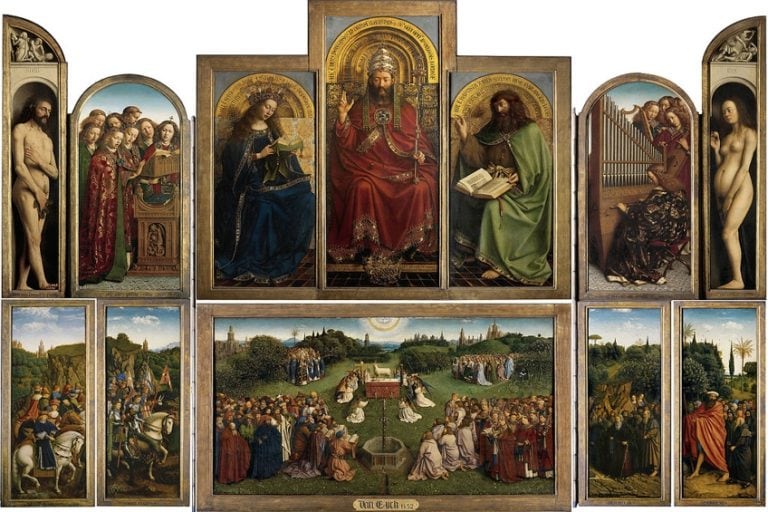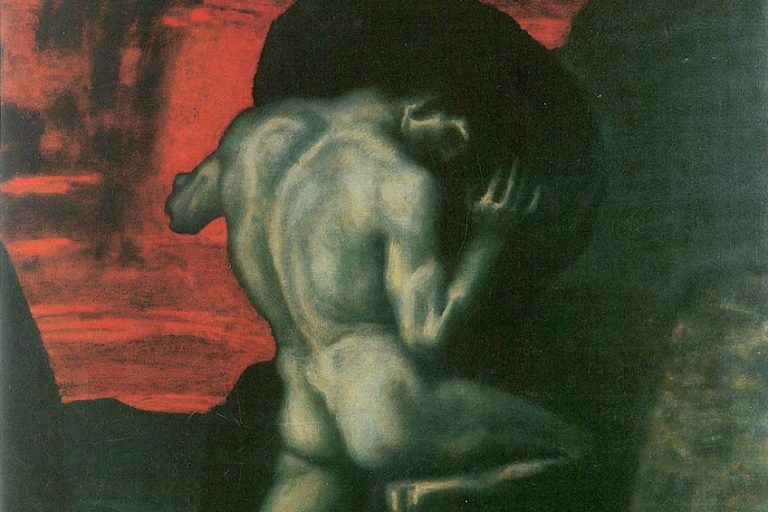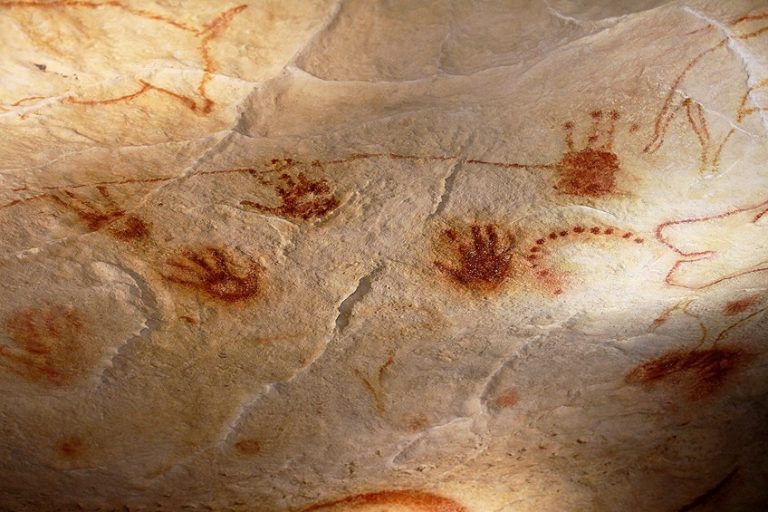What Is Art Brut? – The Raw Beauty of Outsider Art
Have you ever seen a painting or a drawing that seemed quite simple and thought to yourself, “a child could do that”? Or have you ever walked into a gallery and seen an artwork so raw and crude that you found the artist’s uninhibited imagination disturbing? Art Brut may have something to do with it. In the following article, we will discuss what Art Brut is and how it has evolved and influenced art today, as well as some famous artists that contributed to the movement.
What Is Art Brut?
The Art Brut definition is “raw art” in French and refers to art that is naïve, primitive, or even crude in style created by artists outside of the academic tradition of fine art and is also known as Outsider Art (a term coined later in 1972 by Roger Cardinal).
Jean Dubuffet, who invented the term Art Brut in the 1940s and whom we will discuss below, defined Art Brut as including (but not limited to) art made by mentally ill patients, graffiti artists, children, spiritualists, convicts, and primitive artists.
Dubuffet noted that these practitioners were not bound by the constrictions of the academic tradition, but allowed their art to flow freely, expressing their emotions and visions without being hampered by rules and art industry and audience expectations.

Outsider art or art made by artists outside of the mainstream art industry has become quite successful, with journals being published on the subject and events, like the Outsider Art Fair which has been taking place in New York every year since 1993.
Art Brut artworks can also be found at a permanent exhibition held by the Lille Museum of Modern Art, which contains more than 5,500 works of art. Art Brut still influences many artists today, with the movement no longer living on the edges of society but becoming part of the conventional culture while keeping its spontaneous, raw style.
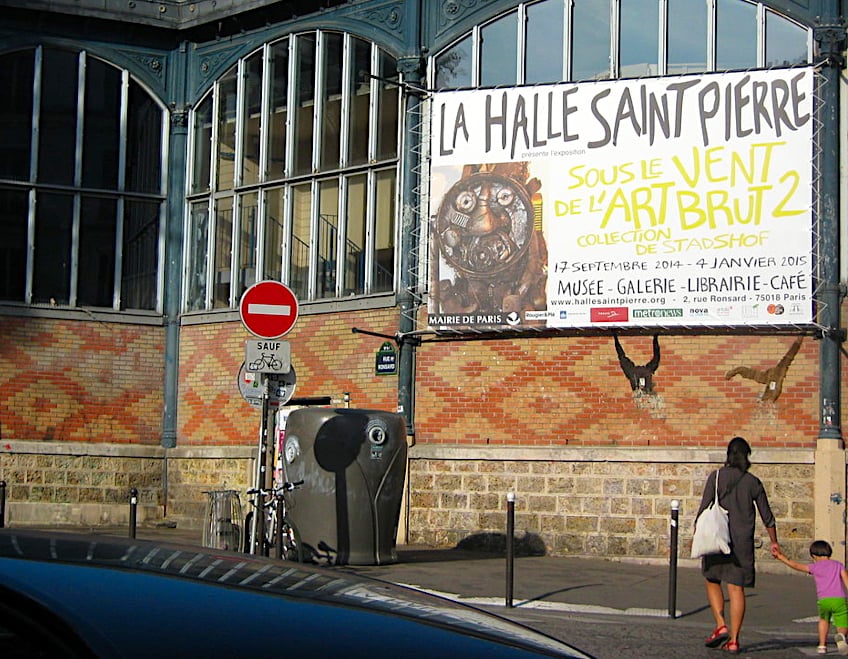
Art of the Mentally Ill, Children, and Peasantry
Art made by the mentally ill, and children, as well as peasant or folk art, has long been of interest to artists before Jean Dubuffet. For example, the Der Blaue Reiter group in the 1910s with artists Wassily Kandinsky, Franz Marc, August Macke, and others were inspired by the expressive quality in the art of these groups because of their “primitivity” or lack of training.
Scenes portrayed by outsider artists often show quirky and unusual ideas, extreme states of mind, and intricate imaginative worlds, and can contain crude, violent imagery.
Artworks made by those with uninhibited or fragile mental states are what initially inspired Jean Dubuffet in creating the Art Brut movement, and in doing so helped to dissolve the stigma surrounding mental illness.
Jean Dubuffet and His Contribution to Art Brut
| Artist | Jean Dubuffet |
| When the Artist Lived | 1901 – 1985 |
| Nationality of the Artist | French |
| Where the Artist Lived | France |
| Associated Art Movements | Modernism |
Jean Dubuffet found that academic training overshadowed fine art and restricted it from flowing freely. By abandoning tradition and society’s values, Art Brut aimed to create works that did not conform to the movements that came before.
Dubuffet admired works by artists who were outside of the academic art tradition, which is reflected in his own work where he wanted to emulate the free expression of societal limitations, but he was not an outsider artist in the true sense because of his status and position in the art industry.
However, his founding of the art movement helped to bring attention to a group of artists and their work who did not seek self-glorification.
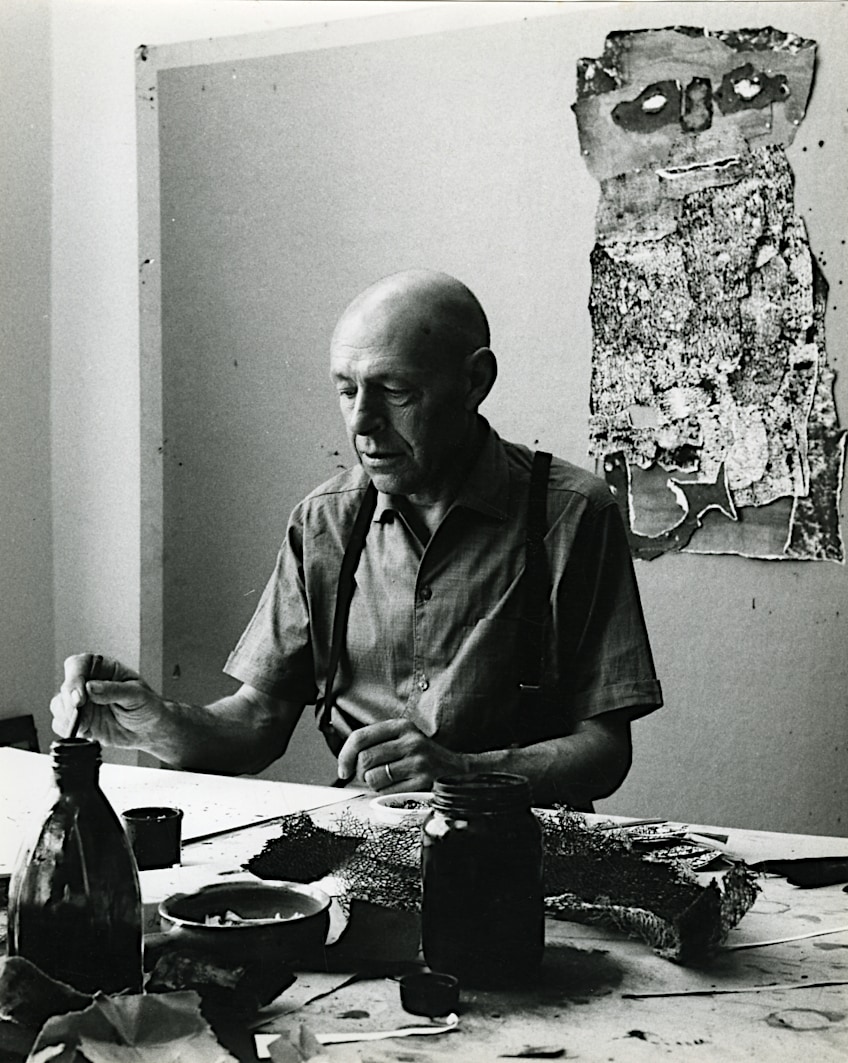
Dubuffet created many pieces of art brut that are held in collections such as at the La Collection de l’Art Brut Museum in Lausanne, Switzerland, and the Musgrave Kinley Outsider Art Collection which is now in Dublin on loan to the Irish Museum of Modern Art.
Skedaddle (L’Escampette) (1964) by Jean Dubuffet
| Date Completed | 1964 |
| Dimensions (cm) | 132.5 x 197.5 x 6 |
| Medium | Painting |
| Where It Is Currently Housed | Stedelijk Museum, Amsterdam, Netherlands |
Skedaddle (1966) is from the series, l’Hourloupe which became his most celebrated series. Dubuffet already had a successful career as the pioneer of Art Brut by the time he started this series, having experimented with many different styles, but l’Hourloupe stuck out. The base of this series was drawing, focusing on clean haphazard lines that bend in random directions with blocks of bold red or blue color against a black or white background.
It all began as a doodle in blue, red, and black ballpoint pen while talking on the telephone with a friend. The image that resulted from the spontaneous movement made with limited color gave birth to the style that the series would become known for.

Some of Dubuffet’s other famous works include:
- Apartment Houses, Paris (1946)
- Grand Maitre of the Outsider (1947)
- The Cow with The Subtle Nose (1954)
- Comments (1978)
Famous Art Brut Artists and Artworks
Apart from Jean Dubuffet, there are other artists who made important contributions to outsider art and Art Brut. Below, we will discuss some of these artists and list a few of their famous works.
Henri Rousseau (1844 – 1910)
| Artist | Henri Rousseau |
| When the Artist Lived | 1844 – 1910 |
| Nationality of the Artist | French |
| Where the Artist Lived | France |
| Associated Art Movements | Post-Impressionism, Primitivism |
Henri Rousseau was a self-taught French artist who came to play an important part in naïve art. At the age of 49, he became a full-time artist, and his work was characterized by his curious compositions and amateurish method which gathered the admiration of artists like Wassily Kandinsky and Pablo Picasso but incited the contempt and mockery of contemporary critics.
Modern artists saw in his work the beauty of simplicity. His style did not incorporate correct proportions, but rather a flat, two-dimensional perspective and the use of unusual colors.

The Dream (1910) by Henri Rousseau
| Date Completed | 1910 |
| Dimensions (cm) | 204 x 298 |
| Medium | Oil on canvas |
| Where It Is Currently Housed | Museum of Modern Art, New York, United States |
The Dream (1910) depicts a woman in a forest surrounded by leafy greenery and animals, such as the two lions who look at the woman and at the viewer. It is interesting to note that Rousseau apparently never left France and therefore never set foot in a jungle. The work is reported to contain 22 shades of green at least.
This scene, which looks quite out of place with a female nude reclining on a couch or sofa in the middle of a jungle is suggestive of images found in some neoclassical paintings of odalisques and may link to the 19th-century French colonial expansion at the time.
The painting is detailed and vibrant, and its bizarre combination of imagery is indicative of why Rousseau’s work was admired by Surrealist artists.

Some of Rousseau’s other famous works include:
- Myself, Portrait-Landscape (1890)
- Surprised! Tiger in a Tropical Storm (1891)
- The Sleeping Gypsy (1897)
- The Hungry Lion Throws Itself on the Antelope (1905)
- The Snake Charmer (1907)
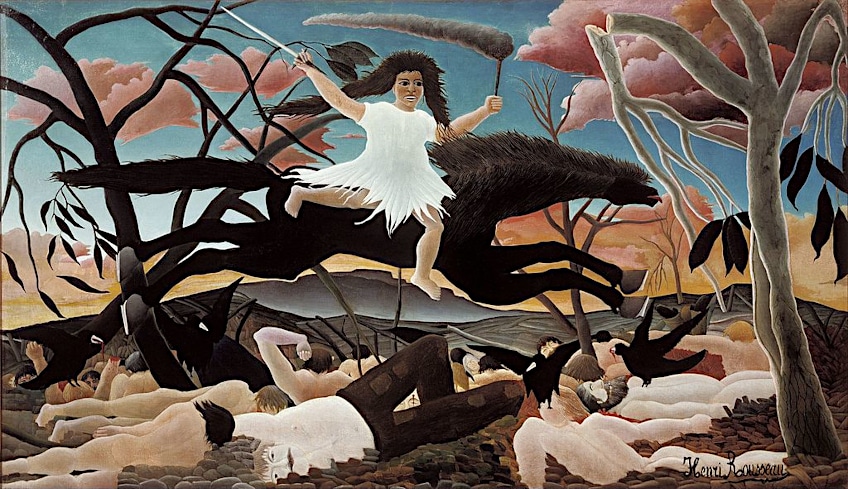
Alfred Wallis (1855 – 1942)
| Artist | Alfred Wallis |
| When the Artist Lived | 1855 – 1942 |
| Nationality of the Artist | British |
| Where the Artist Lived | England |
| Associated Art Movements | Naïve art |
Alfred Wallis was a self-taught British artist who painted seascapes and shipping scenes in an expressive manner using multiple perspectives. A fisherman and mariner, Wallis only started painting when he was 70 years old.
Although he had an influence on modern art and progressive artists, such as Christopher Wood and Ben Nicholson, Wallis’ work did not achieve much commercial success.
He began painting with regular household paint on pieces of cardboard, and his style became known for his interesting positioning of objects, like boats and seaside buildings within the picture plane, creating an expressive almost warped perspective.
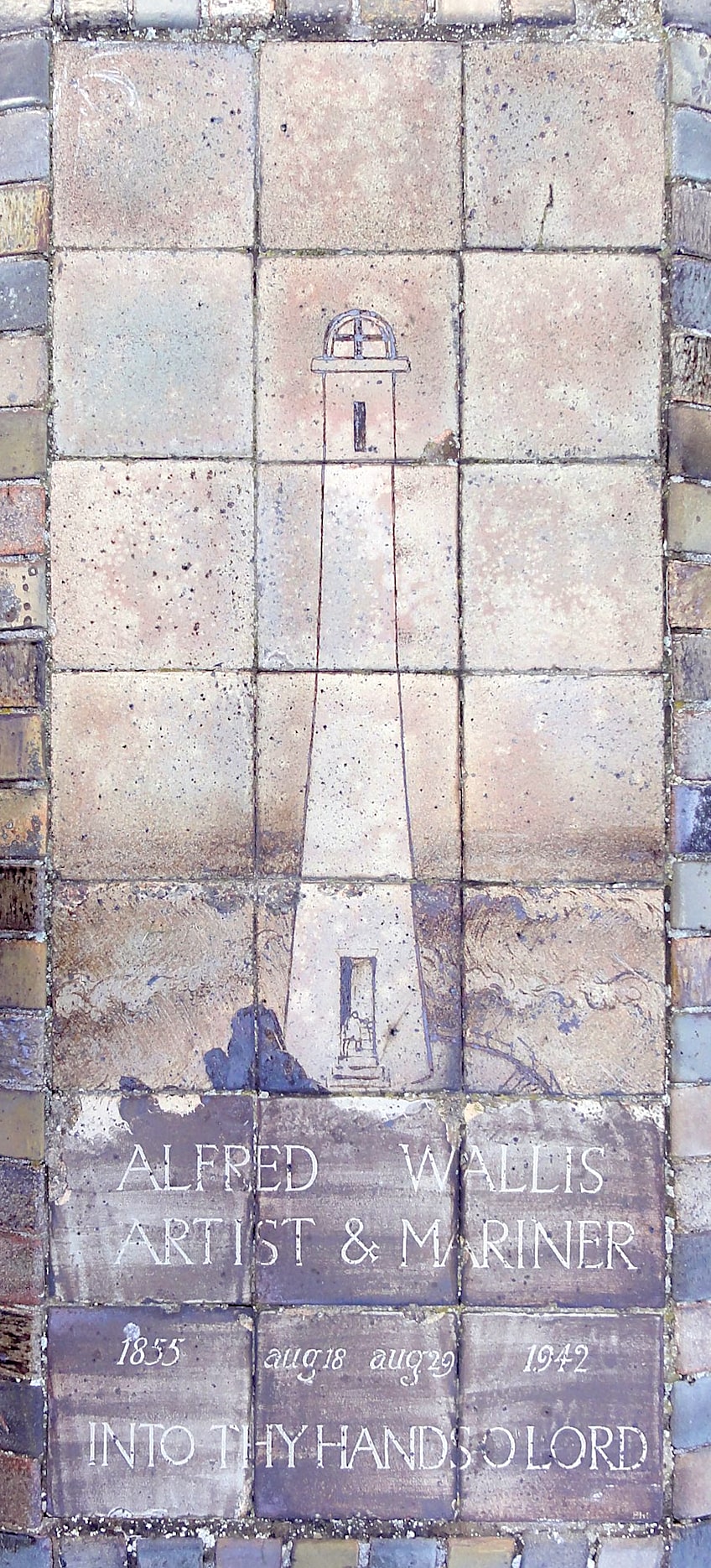
Houses at St Ives, Cornwall (c.1928 – 1933) by Alfred Wallis
| Date Completed | c. 1928 – 1933 |
| Dimensions (cm) | 26.7 x 31.8 |
| Medium | Oil paint on cardboard |
| Where It Is Currently Housed | Tate Modern, London, United Kingdom |
Houses at St Ives, Cornwall (c.1928 – 1933) is a good example of the multi-focal style that characterized Wallis’ work. The artist lived in the fishing town of St Ives, Cornwall, and often painted scenes from his local environment.
In this work, we see various buildings painted in a simple, flat manner. They seem to be floating in space as if the ground beneath is water.
The rules of perspective that would have been learned in a traditional fine art institution are not used here, with some buildings bending and narrowing in a surreal, expressive manner. The picture has a blue hue to it, which further gives it a cold, nautical feel.

Some of Wallis’ other famous works include:
- Ives (1928)
- Crucifixion or Allegory with Three Figures and Two Dogs (1932 – 1934)
- Land, Fish and Motor Vessel (1932 – 1937)
- Voyage to Labrador (1935 – 1936)
Grandma Moses (1860 – 1961)
| Artist | Grandma Moses |
| When the Artist Lived | 1860 – 1961 |
| Nationality of the Artist | American |
| Where the Artist Lived | United States |
| Associated Art Movements | Naïve Art |
Anna Mary Robertson Moses, known as the American artist Grandma Moses, started every day in her mid-70s and produced work until she was 100 years old. Since childhood, she resisted the patriarchal stereotype of a girl or woman belonging inside the house, and we may see that reflected in her work which focuses on the wonders of outdoor activities.
Romantic, and playful, busy scenes of people going about their day dominate her landscapes. Grandma Moses was self-taught and worked alone.
As an Outsider Artist, her paintings contained a nativity about them, but rather than anxious and dark feelings often linked with Art Brut, her work was filled with joy and nostalgia and leaned towards a folk style that appealed to many beyond the art world.

Sugaring Off (1943) by Grandma Moses
| Date Completed | 1943 |
| Dimensions (cm) | 91.4 x 114.3 |
| Medium | Oil on pressed board |
| Where It Is Currently Housed | Private Collection |
Sugaring Off (1943), the term meaning to boil the sap of the maple tree until it turns into a thick syrup or turns into sugar through crystallization, was a popular theme of Grandma Moses. In this painting, a busy scene is depicted with many figures involved in the process of sugaring. Buildings such as houses and a church peek through the white snowy landscape. Although the scene is festive, we are also reminded of the harsh rural life in Winter.
This series of works in which Grandma Moses both indicates the busy life of country living as well as its romantic charm, led to their great praise. Critics did not like the parts of her art that evidenced her lack of training but work like Sugaring Off made her appealing to the public.

Some of Moses’ other famous works include:
- Shenandoah Valley (1938)
- Catching the Thanksgiving Turkey (1943)
- The Old Checkered House, 1853 (1944)
- Hoosick River, Summer (1952)
Niko Pirosmani (1862 – 1918)
| Artist | Niko Pirosmani/Pirosmanashvili |
| When the Artist Lived | 1862 – 1918 |
| Nationality of the Artist | Georgian |
| Where the Artist Lived | Georgia |
| Associated Art Movements | Naïve art |
Niko Pirosmani was a self-taught artist from Georgia and through his art, documented the lifestyle, culture, traditions, environments, and customs native to this developing country. He is known for having used a neutral color palette for the most part and cheap materials.
Pirosmani was a poor, struggling artist and did not make much money from the works he produced, but they were many and he became a celebrated artist after his death.
Because he had no formal art training, Pirosmani’s style was quite unique, with a dynamic, folk-art flavor that was simple yet impactful.

Soviet stamp celebrating the 125th anniversary of Niko Pirosmani’s birthday; Post of the USSR, designer Русский: Почта СССР, художник А. Шмидштейн Originally from ru.wikipedia., Public domain, via Wikimedia Commons
Portrait of Ilya Zdanevich (1913) by Niko Pirosmani
| Date Completed | 1913 |
| Dimensions (cm) | 150 x 120 |
| Medium | Oil on cardboard |
| Where It Is Currently Housed | Private Collection |
Portrait of Ilya Zdanevich (1913) depicts Ilya Zdanevich, a promoter for the avant-garde and poet who had a significant impact on Pirosmani’s artistic career when he and his brother took some works with them to Moscow to be featured in the Target exhibition in 1913. This gave Pirosmani a larger platform for his art to be seen apart from in bars and restaurants in Tbilisi, Georgia.
In this portrait, the figure is quite flat against a rural background with trees and plants. He is wearing Russian clothing but is painted in a traditional Georgian style. The colors are dark and painted on affordable cardboard, characteristic of Pirosmani’s work.

Some of Pirosmani’s other famous works include:
- Feast in the Grape Pergola or Feast of Three Noblemen (1905)
- Signboard ‘Cold, Cold Beer’ (1910)
- Roe Deer Drinking from A Stream ([s.a])
- Wedding in the Old-Times Georgia (1916)

In conclusion, Art Brut has had a major influence on the art world, bringing attention to works that would have been previously overshadowed, ignored, or criticized by fine art academics and critics. We hope that this article has helped to broaden your understanding of this unique movement in art history and, if you have been inspired, to further your exploration into Art Brut.
Take a look at our art brut webstory here!
Frequently Asked Questions
What Is Art Brut?
The Art Brut definition is raw art in French and refers to art that is primitive, informal, or naïve in style. It is created by artists outside of the academic tradition of fine art or artists who have had no formal training and is therefore also known as Outsider Art. By abandoning tradition and society’s values, Art Brut artists aimed to create works that did not conform to the movements that came before.
Who Introduced the Art Brut Movement?
Jean Dubuffet (1901–1985) was a French painter who advocated art that shows a lack of formal art training, which is often rudimentary or primitive in style. He is famous for founding the Art Brut movement in the 1940s and helped to bring attention to a group of artists and their work who did not seek self-glorification.
Jaycene-Fay Ravenscroft is a writer, poet, and creative living in South Africa with over 6 years of experience working in a contemporary art gallery. She completed her Bachelor of Arts degree, majoring in Art History and Ancient History at the University of South Africa, with additional subjects in Archaeology and Anthropology.
With a passion for learning, Jaycene-Fay is very much inspired by symbology and the connection between everything in this world. Trained to analyze and ‘critique’ art, she is passionate about exploring the meaning behind each artwork she encounters and understanding how it connects to the artist’s cultural, historical, and social background. Writing is Jaycene-Fay’s way of having a finger in every pie: to research, share knowledge, and express herself creatively.
Learn more about Jaycene-Fay Ravenscroft and the Art in Context Team.
Cite this Article
Jaycene-Fay, Ravenscroft, “What Is Art Brut? – The Raw Beauty of Outsider Art.” Art in Context. February 10, 2023. URL: https://artincontext.org/what-is-art-brut/
Ravenscroft, J. (2023, 10 February). What Is Art Brut? – The Raw Beauty of Outsider Art. Art in Context. https://artincontext.org/what-is-art-brut/
Ravenscroft, Jaycene-Fay. “What Is Art Brut? – The Raw Beauty of Outsider Art.” Art in Context, February 10, 2023. https://artincontext.org/what-is-art-brut/.





